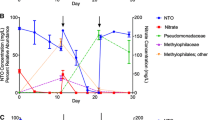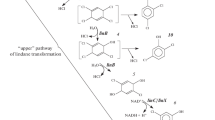Abstract
Microorganisms derived from soil, sludge, sewage or river water contaminated by detergents or mineral oils were enriched and tested for the capability of primary biodegradation of dialkyl sulfosuccinates (DASS). Adapted mixed cultures, containing predominantly Gram-negative bacteria, degraded di-n-hexyl sulfosuccinate (DHSS) more readily than di-n-octyl sulfosuccinate (DOSS). Bacterial isolates obtained from enriched mixed cultures that show the highest rates of primary biodegradation and assimilation of DASS belong to the genusComamonas. Under nongrowth conditions, the DHSS primary biodegradation by these strains follows the 1st order reaction kinetics. The rate constants of primary degradation of DHSS by resting cells ofC. terrigena N3H were found to be 30 times higher than when catalyzed byC. terrigena N1C. The capacity for accelerated removal of surface-active properties of DHSS byC. terrigena N3H was retained within the range of pH 4–10 and at temperatures up to 55°C, while DHSS degradation byC. terrigena N1C was completely inhibited above 48°C. Temperature and pH limits for DHSS primary degradation by both strains were to a great extent wider than those for the viability of the cultures. Biodegradation capacity and metabolic stability ofC. terrigena N3H make this strain interesting from both scientific and technological point of view.
Similar content being viewed by others
References
Bernett M.K., Zisman W.A.: Relation of wettability by aqueous solutions to the surface constitution of low energy solids.J. Phys. Chem. 6, 1241–1246 (1959).
Cappuccino J.G.: Serial dilution agar plating procedure to quantitate viable cells, pp. 77–80 in J.G. Cappucino, N. Sherman (Eds):Microbiology. The Benjamin Cummings Publ. Co. 1992.
Gregorová D., Augustín J., Vrbanová A., Sládeková D.: Effect of dialkyl sulphosuccinates on respiration activity of degradative and nondegradative bacteria.Biologia 51, 234–247 (1996).
Hales S.G.: Biodegradation of anionic surfactant dialkyl sulphosuccinate.Environ. Toxicol. Chem. 12, 1821–1828 (1993).
Hayashi K.: A rapid determination of sodium dodecylsulphate with methylene blue.Analyt. Biochem. 67, 503–506 (1975).
Húska J., Závadská I., Tóth D., Dobrotová M., Gemeiner P.: Immobilization of surfactant degrading bacteria in alginate gel.Biologia 51, 279–283 (1996).
Mankowich A.M.: Micellar molecular weights of selected surface active agents.J. Phys. Chem. 58, 1027–1030 (1954).
Merkel G.J., Perry J.J.: Effect of growth substrates on thermal death of thermophilic bacteria.Appl. Environ. Microbiol. 34, 326–329 (1977).
Swisher R.D.:Surfactant Biodegradation, Surfactant Science Series, 18. Marcel Dekker, New York 1987.
Tóth D., Húska J., Závadská I., Dobrotová M.: Effect of bacterial starvation on surfactant biotransformation.Folia Microbiol. 41, 477–479 (1996).
White G.F.: Biodegradation of anionic surfactants, pp. 143–176 in C. Ratledge (Ed.):Biochemistry of Microbial Degradation. Kluwer Academic Publishers, Amsterdam 1994.
Zaková D., Ferianc P., Polek B., Godočíková J., Tóth D.: Capacity of planktonic and epilithic microbial assemblages from water of the Danube to biodegrade sodium dodecyl sulphate and dioctyl sulphosuccinate.Biologia 51, 259–270 (1996).
Author information
Authors and Affiliations
Rights and permissions
About this article
Cite this article
Prokšová, M., Augustín, J. & Vrbanová, A. Enrichment, isolation and characterization of dialkyl sulfosuccinate degrading bacteriaComamonas terrigena N3H andComamonas terrigena N1C. Folia Microbiol 42, 635–639 (1997). https://doi.org/10.1007/BF02815478
Received:
Revised:
Issue Date:
DOI: https://doi.org/10.1007/BF02815478




